Chrysanthemum dishes in Japan showcase the culinary use of chrysanthemum flowers. These dishes highlight edible chrysanthemums’ visual and flavorful appeal, incorporating them into salads, tempura, hot pots, and beverages. Traditional practices include soaking chrysanthemum flowers in sake to create aromatic chrysanthemum wine. The use of chrysanthemums in Japanese cuisine reflects a cultural appreciation for this flower’s aesthetic and culinary aspects. Now, let’s get to know more about it.
What are Chrysanthemum dishes?
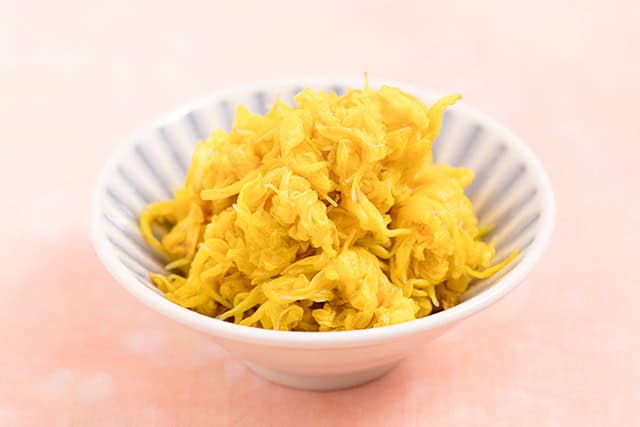
In Japan, Chrysanthemum dishes use edible chrysanthemum flowers in various culinary applications or cuisines. In Japanese cuisine, edible chrysanthemums are not only for their visual appeal but also for their unique flavor. These dishes can include chrysanthemum petals in salads, tempura, hot pot dishes, and even in beverages. In some traditional practices, locals soaked chrysanthemum flowers in sake to create aromatic chrysanthemum wine.
Many local dishes are made with chrysanthemums in Yamagata Prefecture, where people like to grow and eat chrysanthemums (not the small ones used as decorations for raw fish). Back in the day, folks used to soak chrysanthemum flowers in sake to make a tasty chrysanthemum wine, and they would steam and dry the petals for cooking. Chrysanthemums aren’t just pretty; they have a unique taste, smell, and texture. They’re bitter and pungent, but if you boil them for a while, that bitterness disappears, and a pleasant scent emerges. So, to make them delicious, people take out the bitter tips and the short petal part from the middle of the flower.
Chrysanthemum dishes History
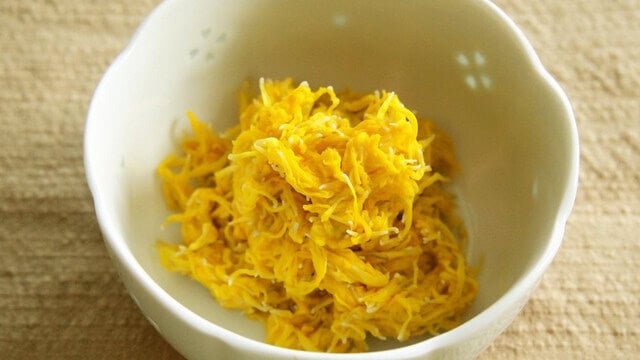
The story of chrysanthemums has different tales. But according to plant expert Shiro Kitamura, they were split into two types, Chrysanthemum japonica in the north and Chrysanthemum chrysanthemum in the south, during China’s Tang Dynasty or earlier. These flowers likely came to Japan from China around 729-749 AD. In the Edo period, chrysanthemums were cultivated for beauty, but people started eating their flowers and leaves over time. In ancient China, they enjoyed the chrysanthemums for their health benefits in the form of tea, wine, and herbal medicine. The chrysanthemums we eat today is less bitter with larger petals. In Japan, edible chrysanthemums like “Kakinomoto” were introduced from China during the Nara period. People have been eating them since the Edo period, and historical records even mention a dish called “Amagiku” in 1695. The famous poet Matsuo Basho also wrote a haiku about chrysanthemums in 1690.
Seasons for eating
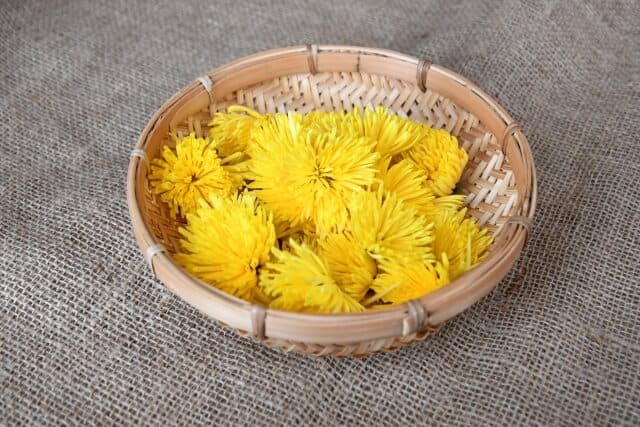
Eating chrysanthemums is a seasonal treat that happens from autumn to early winter, but you can enjoy them from May to January now due to advances in breeding. The peak time for harvesting, though, is from late October to early November. Specifically, during the Chrysanthemum Festival on September 9th, you can find yellow chrysanthemums symbolizing “Kotobuki” (longevity and happiness) available for purchase.
How to eat?

To enjoy chrysanthemums, focus on eating the petals. First, wash the chrysanthemum, remove the petals from the base, and boil them in water with vinegar to bring out their beautiful color, thanks to the anthocyanin content. After cooking, rinse the petals with cold water, let them drain, and then you can eat them with soy sauce or a soy sauce and dashi blend. People in the prefecture appreciate the chrysanthemum’s distinct crunchy texture and slightly bitter taste. You can also get creative with how you eat them – mix them with spinach or grate them to pair with seasoned nameko mushrooms and wild vegetables. Chrysanthemums taste great with walnuts, too. Adding walnuts to your dish or making a special “walnut dressing” enhances the flavor and makes it rich and delicious.
Of course, you should eat the petals. The calyx is hard and has a strong bitter taste, so tear off the petals before using. We recommend scattering the chrysanthemum petals on the sashimi with soy sauce. Adding it as a topping to soups or aemono will add color to the dish. You can enjoy it as chrysanthemum tea by putting it in a cup and pouring boiling water over it.
Types of edible chrysanthemums
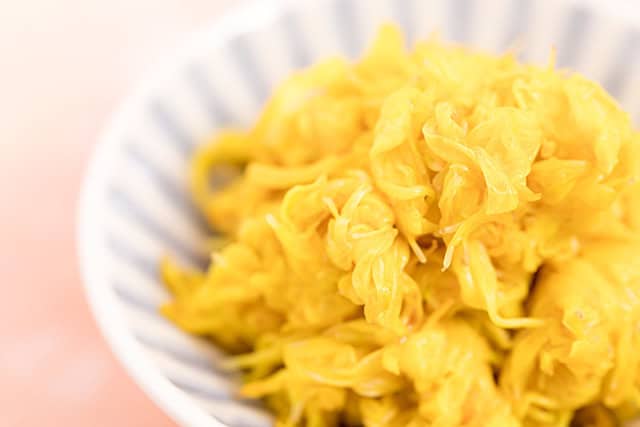
Edible chrysanthemum
This small chrysanthemum flower looks like a dandelion and is mainly used as a decoration for sashimi. Aichi Prefecture produces about 90% of these flowers in the country, using improved varieties and greenhouse cultivation. The tradition of adding chrysanthemums to sashimi dates back to the Edo period, when people believed the flowers had detoxifying and antibacterial effects. To eat them, you usually tear off the petals and sprinkle them on top of your sashimi or mix them with soy sauce for a tasty combination with the raw fish.
Abogu Shrine
This chrysanthemum, also known as “Abougiku” or “Abonomiya,” is a double yellow flower with hardly any bitterness and a delightful fragrance. Aomori and Iwate prefectures are the primary places where these chrysanthemums are grown. Aomori has a unique product called “dried chrysanthemums” (kiku-nori), made by steaming the petals of Abonomiya flowers and then drying them into flat pieces.
Enmeiraku
This chrysanthemum, also known as “Motte no other” or “Motte chrysanthemum,” earned its nicknames from the idea of “eating chrysanthemums, the emblem of the imperial family,” and being “delicious beyond all expectations.” It’s a double chrysanthemum with pink-purple hues, and its petals are curled like tubes, giving it a crunchy texture. It’s primarily grown in Yamagata and Niigata prefectures with a pleasant aroma, slightly sweet taste, and hardly any bitterness.
Health Information about Chrysanthemum dishes
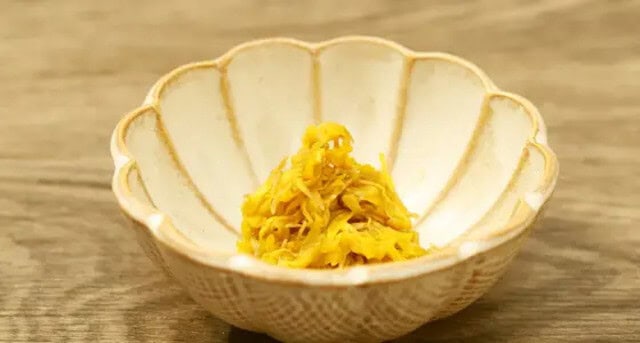
Edible chrysanthemums offer a range of nutritional benefits and health effects. Rich in vitamin E, these flowers act as potent antioxidants, protecting the body from active oxygen and improving blood flow. These can alleviate symptoms like stiff shoulders and sensitivity to cold resulting from circulation issues. Vitamin K in chrysanthemums also plays a crucial role in proper blood clotting and bone health. It aids in stopping bleeding when injuries occur. It supports calcium absorption for bone strength and benefits conditions like osteoporosis.
Moreover, chrysanthemums contain essential B vitamins such as B1 and B2, promoting efficient carbohydrate metabolism, energy production, and cell regeneration in the skin, mucous membranes, hair, and nails. Folic acid, another B-group vitamin, is essential for red blood cell production, DNA and RNA synthesis, and overall cell regeneration. Particularly vital for pregnant and breastfeeding women, folic acid supports the normal development of the fetus. The polyphenol chlorogenic acid found in chrysanthemums is a potent antioxidant, moderating sugar absorption and suppressing fat accumulation. The flowers’ essential oils contribute to detoxification, anti-inflammatory, and antibacterial effects, making them a valuable addition to dishes like sashimi.
Medicinally, edible chrysanthemums are believed to prevent headaches, hot flashes, and hay fever during seasonal transitions and to address eye issues, high blood pressure, and skin breakouts. Chinese medicine also utilizes them as herbal remedies, which can be consumed as tea after drying.
Chrysanthemum dishes FAQ
- How are Chrysanthemum petals typically prepared in these dishes?
In Chrysanthemum dishes, the preparation of petals is a key focus. Typically, the petals are boiled briefly in water with a touch of vinegar to enhance their color. After boiling, they are rinsed with cold water, drained, and served.
- What is the taste of Chrysanthemum?
The taste of Chrysanthemum dishes in Japan is characterized by a unique combination of flavors. Edible chrysanthemum petals typically have a slightly bitter and crisp texture. The bitterness is often managed through culinary techniques, such as boiling or removing bitter parts, to enhance the overall dining experience.
Chrysanthemum dishes Recipe
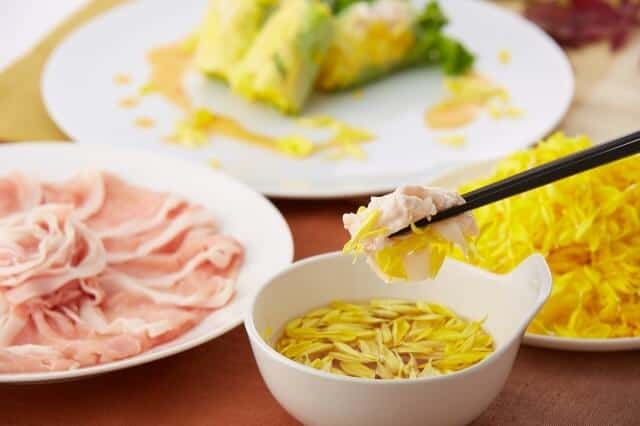
Chrysanthemum dishes Ingredients
| Ingredients of Chrysanthemum dishes for 4 persons | Measurements |
|---|---|
| Edible mushrooms | 100g |
| Vinegar for boiling | 20g |
| Soy sauce | 20g |
| Walnut | 5g |
How to make Chrysanthemum dishes?
Wash and scatter the edible calyxes, removing the petals from them.
Prepare a boiling pot; add vinegar and boil the mushrooms when the water boils. Because the pieces are light, they tend to float, so it’s a good idea to use chopsticks to flip the top side down.
Drain in a colander, run under cold water, and squeeze out the water. Arrange in a bowl and sprinkle with soy sauce. If desired, sprinkle with chopped walnuts and serve as a tempura.
Where to buy Chrysanthemum dishes?
Tawaraya (日本の味俵屋&しんぶんカフェ)
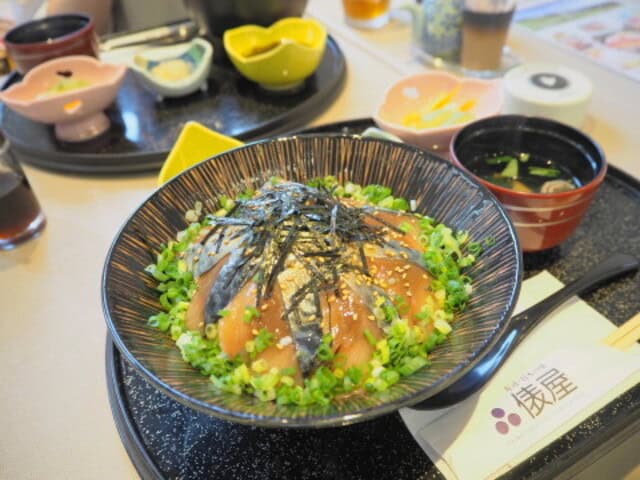
Tawaraya is a sushi and new local cuisine restaurant that opened in Hachinohe City about 40 years ago. New local cuisine refers to creative cuisine that uses local ingredients. At Tawaraya, you can enjoy mackerel chrysanthemum rolls. Shimesaba from Hachinohe boasts a 70 to 80% national market share. Among them, silver mackerel has a reputation for being fatty and delicious. This chrysanthemum roll made with mackerel is also beautifully colored.
Minato Murafuku (八戸菓子匠 港むら福)
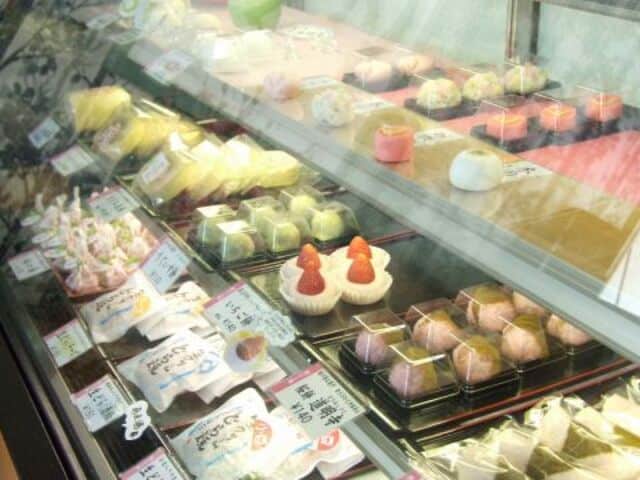
The restaurant “Minato Murafuku,” founded in 1924, serves a dish full of chrysanthemums called “Kikuka Ryoran.” All 10 dishes, from appetizers to soups, use edible Kikuabangiya. Kikuka Ryoran has been served as a distinctive dish using Nanbu Town’s specialty products since shortly after Cheerius opened.
Takeaway
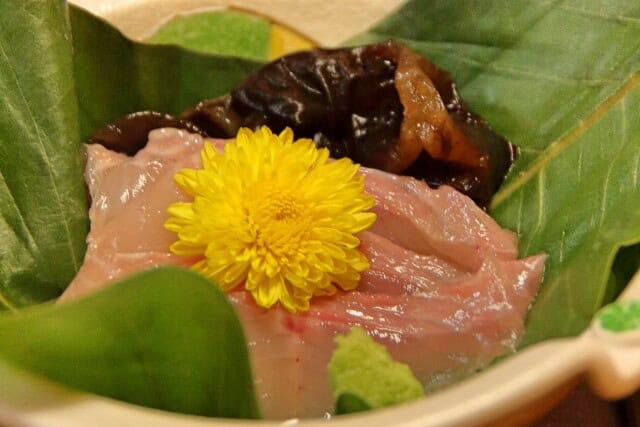
From the petals’ slight bitterness and crisp texture to the subtle sweetness and floral aroma, these dishes showcase the artistry of incorporating edible chrysanthemums into Japanese cuisine. Whether enjoyed in salads, tempura, hot pots, or as a garnish for sashimi, each preparation reflects a cultural appreciation for this versatile flower’s aesthetic and culinary aspects. I hope readers have gained valuable insights by exploring the flavors, traditions, and nutritional benefits associated with Chrysanthemum dishes.
You can check some Japanese dishes like Daigaku imo and Hanabira mochi that we know you would like to try too.
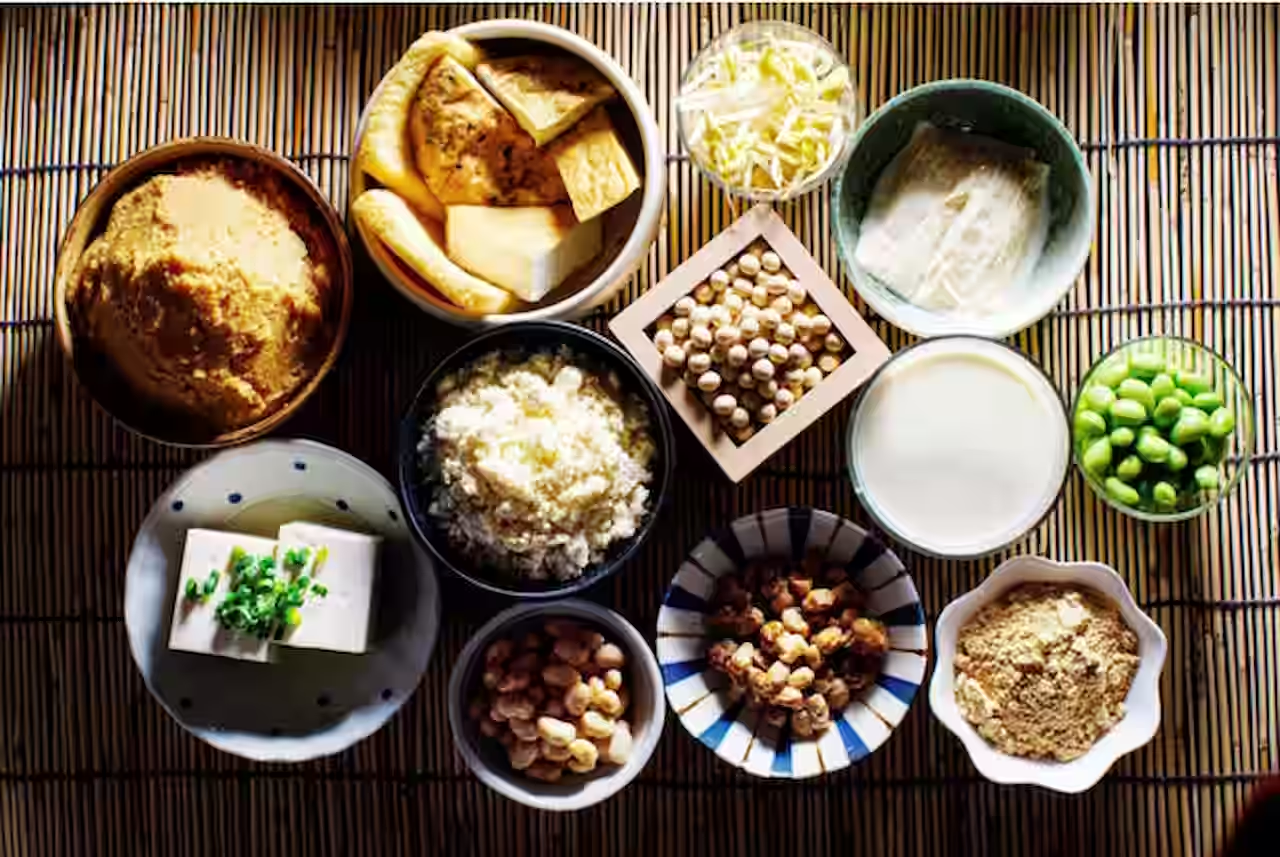





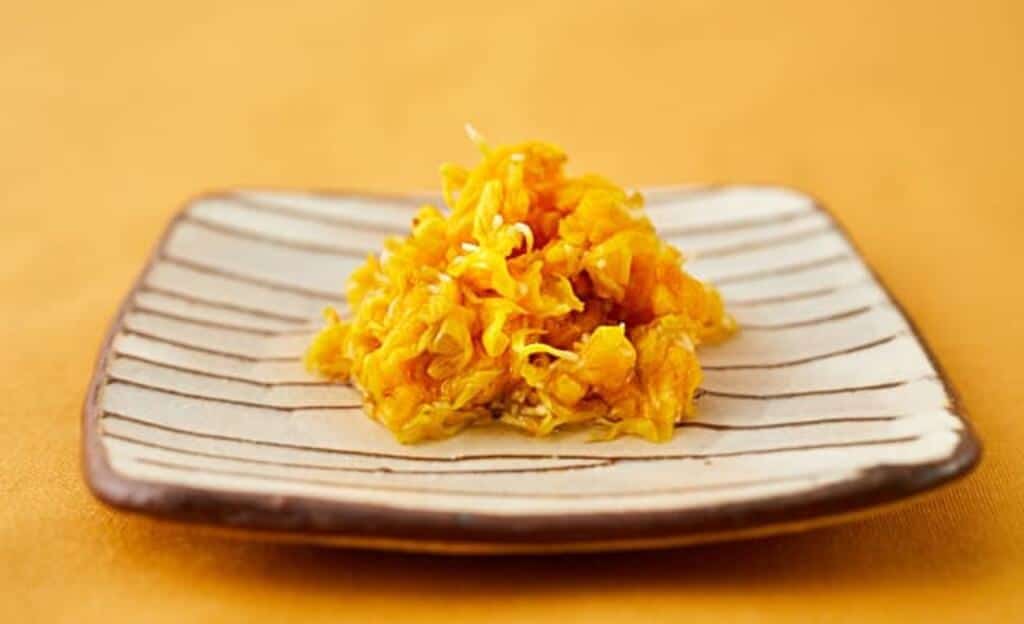
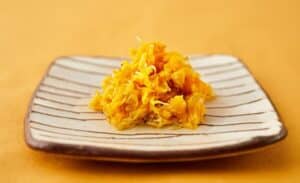
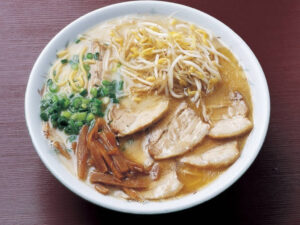
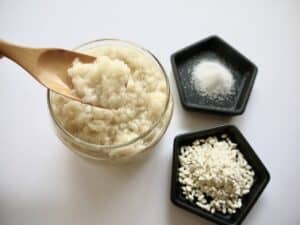
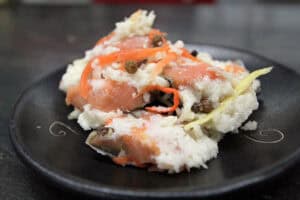
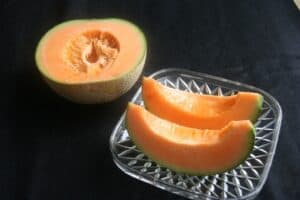
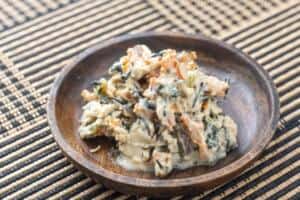
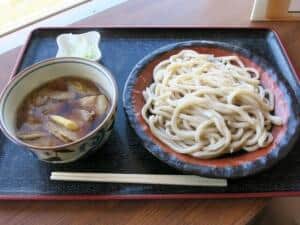
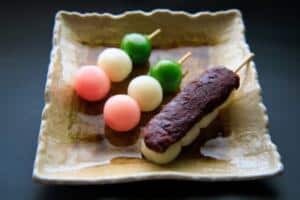
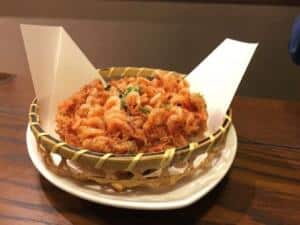
Comments